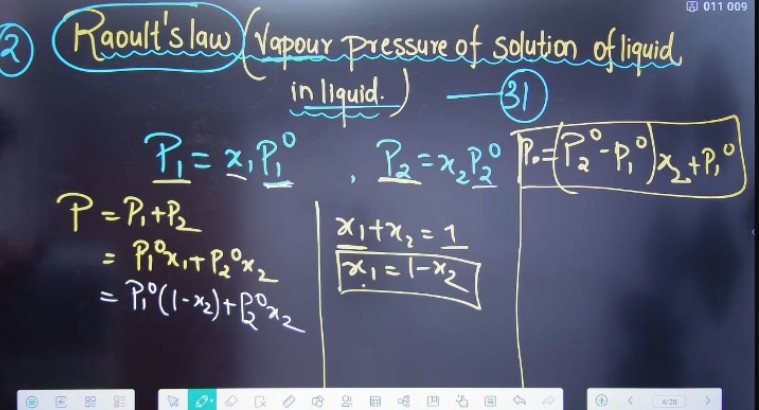Explain Raoult's Law and its equations for vapor pressure of a solution of liquid in liquid.

Understand the Problem
The image shows notes defining Raoult's Law, relevant to the vapor pressure of a solution of liquid in liquid. It presents equations and relationships between partial pressures, mole fractions, and vapor pressures in the context of ideal solutions.
Answer
Raoult's Law relates the vapor pressure of a solution to the mole fraction and vapor pressure of its components: P1 = x1 * P1^0, P2 = x2 * P2^0, P = P1 + P2.
Raoult's Law states that the partial vapor pressure of each component of an ideal mixture of liquids is equal to the mole fraction of the component in the mixture times the vapor pressure of the pure component. The equations are:
P1 = x1 * P1^0 P2 = x2 * P2^0 P = P1 + P2 = P1^0 * x1 + P2^0 * x2
Answer for screen readers
Raoult's Law states that the partial vapor pressure of each component of an ideal mixture of liquids is equal to the mole fraction of the component in the mixture times the vapor pressure of the pure component. The equations are:
P1 = x1 * P1^0 P2 = x2 * P2^0 P = P1 + P2 = P1^0 * x1 + P2^0 * x2
More Information
Raoult's Law is most accurate for ideal solutions, where the interactions between molecules are similar to those in the pure liquids. Deviations occur when the interactions are significantly different.
Tips
A common mistake is to forget that Raoult's Law applies to ideal solutions. Real solutions may show deviations, especially when the components have very different intermolecular forces.
Sources
- Raoult's Law - Chemistry LibreTexts - chem.libretexts.org
- Raoult's Law - Definition, Formula, Deviations, Relationship with ... - byjus.com
AI-generated content may contain errors. Please verify critical information